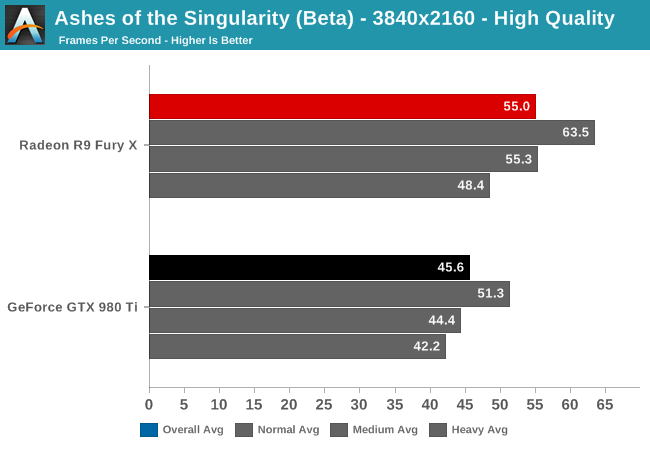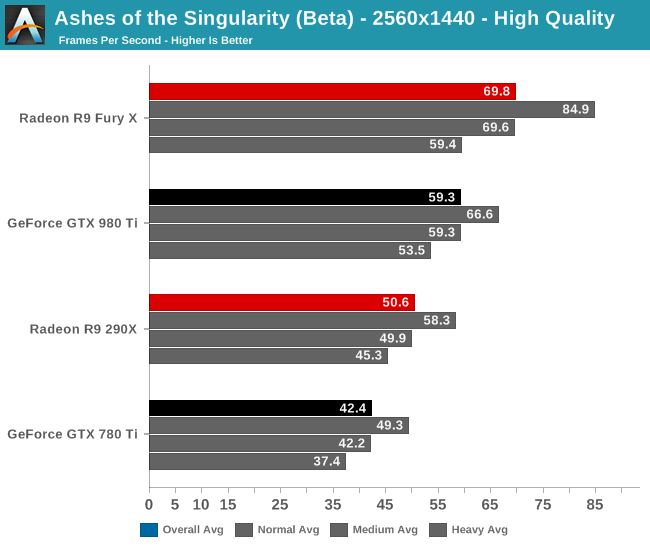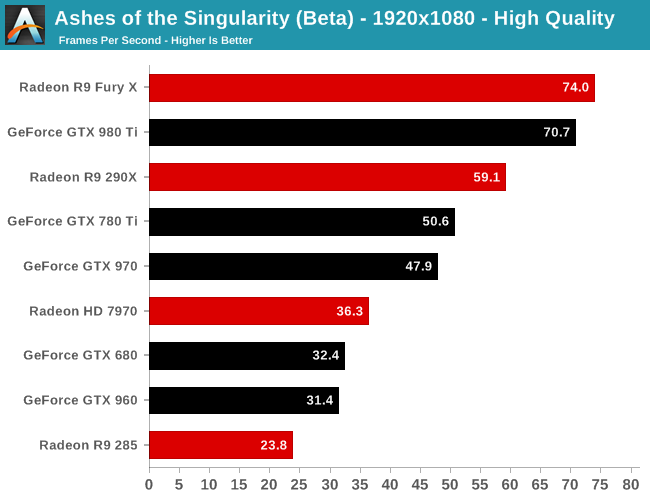Ashes of the Singularity Revisited: A Beta Look at DirectX 12 & Asynchronous Shading
by Daniel Williams & Ryan Smith on February 24, 2016 1:00 PM ESTDirectX 12 Single-GPU Performance
We’ll start things off with a look at single-GPU performance. For this, we’ve grabbed a collection of RTG and NVIDIA GPUs covering the entire DX12 generation, from GCN 1.0 and Kepler to GCN 1.2 and Maxwell. This will give us a good idea of how the game performs both across a wide span of GPU performance levels, and how (if at all) the various GPU generational changes play a role.
Meanwhile unless otherwise noted, we’re using Ashes’ High quality setting, which turns up a number of graphical features and also utilizes 2x MSAA. It’s also worth mentioning that while Ashes does allow async shading to be turned off and on, this option is on by default unless turned off in the game’s INI file.

Starting at 4K, we have the GeForce GTX 980 Ti and Radeon R9 Fury X. On the latest beta the Fury X has a strong lead over the normally faster GTX 980 Ti, beating it by 20% and coming close to hitting 60fps.

When we drop down to 1440p and introduce last-generation’s flagship video cards, the GeForce GTX 780 Ti and Radeon R9 290X, the story is much the same. The Fury X continues to hold a 10fps lead over the GTX 980 Ti, giving it an 18% lead. Similarly, the R9 290X has an 8fps lead over the 780 Ti, translating into a 19% performance lead. This is a significant turnabout from where we normally see these cards, as 780 Ti traditionally holds a lead over the 290X.
Meanwhile looking at the average framerates with different batch count intensities, there admittedly isn’t much remarkable here. All cards take roughly the same performance hit with increasingly larger batch counts.

Finally at 1080p, with our full lineup of cards we can see that RTG’s lead in this latest beta is nearly absolute. The 2012 flagship battle between the 7970 and the GTX 680 puts the 7970 in the lead by 12%, or just shy of 4fps. Elsewhere the GTX 980 Ti does close on the Fury X, but RTG’s current-gen flagship remains in the lead.
The one outlier here is the Radeon R9 285, which is the only 2GB RTG card in our collection. At this point we suspect it’s VRAM limited, but it would require further investigation.










153 Comments
View All Comments
extide - Wednesday, February 24, 2016 - link
If you are CPU limited, and it's using lots of threads, then yeah more cores would be faster. They were CPU limited on an overclocked 4960X, which is no slouch, that was very surprising!rhysiam - Wednesday, February 24, 2016 - link
I agree that will be very interesting. I'm surprised more hasn't been made of the seemingly pretty hard CPU limit to ~70fps, irrespective of the detail settings or resolution. And that on a still very capable 4960X @ 4.2Ghz. If we estimate Skylake has a 20% IPC advantage, that would still see the current top tier 6700K (at stock) maxing out in the mid 80s, a long way short of what you might like on a 144hz monitor. Does that mean a brand new quad core CPU like the i5 6400 with its low base clock might struggle to sustain 60fps, even on lower detail settings?I realise this is beta and all preliminary, but it's interesting nonetheless.
DanNeely - Wednesday, February 24, 2016 - link
Does DX12 Multi-adapter offer any benefits with cards that are mismatched in performance? I'm currently running a GTX 980 in my main PC and also have an older GTX 770 sitting around; would pairing them offer any speedup over just the 980, or would the faster card end up held back by the slower one?I'd be equally interested in seeing how AMD does with significantly mismatched GPUs; since they've been trying (with varying degrees of success) to push XFire between their IGPs and the significantly faster chips in midrange Radeon cards.
BigLan - Wednesday, February 24, 2016 - link
The article has a quote from the developer about using mismatched cards..."For example, you will never get more than twice the speed of the slowest video card. You would be better off just using the new card alone."
You might get some benefit, but likely not that much.
Friendly0Fire - Wednesday, February 24, 2016 - link
I think that's rather narrow minded and way too absolute. Mismatched cards can be used to their full potential, but you'd need some smart coding to make it so. For instance, you could offload some of the work to the weaker GPU, keeping the stronger one for the main rendering.One excellent example which would fully utilize two mismatched cards is VR: multiadapter rendering would be used to offload the VR projection and transformation steps to the integrated GPU in most modern CPUs, while the main GPU would do the regular rendering. The data transfer requirement is minimal, but there's a fair amount of computations required, making it an ideal scenario.
Other examples include doing post-processing on the weaker card (SSAO, subsurface scattering, screenspace reflections, etc.). The big problem is judging just how much work should be offloaded to the secondary GPU - just detecting the hardware would be extremely laborious.
Ryan Smith - Wednesday, February 24, 2016 - link
It's a correct description for how Ashes works. They implement a (relatively) straightforward AFR setup, so the cards need to be similar in performance.Senti - Wednesday, February 24, 2016 - link
What Multi-adapter does is left completely to developer. In some cases it can give you nothing, in others every bit of hardware can be useful including iGPU.extide - Wednesday, February 24, 2016 - link
Their current implementation is AFR, so the performance of the cards should be as close to identical as possible. In the future I think they may plan on offloading some of the raw compute onto a second GPU, and in that case an older slower GPU would be beneficial.Drumsticks - Wednesday, February 24, 2016 - link
These are always interesting results to see. I'm pretty excited for Polaris - I can't wait to pickup a higher end GPU to replace my old, old 7850.mattevansc3 - Wednesday, February 24, 2016 - link
Isn't Oxide's statement that they don't optimise for certain hardware a bit disingenuous?If you read their developer diaries not only was AoS built around Mantle, not only was the engine built upon Mantle but they've stated that they developed more of Mantle than AMD did.
Before DX12 was even announced Oxide were working directly with AMD and building AoS to champion Mantle and take advantage of it a low level while only supporting nVidia hardware on DX11. That of course will automatically bias results in favour of RTG even if there is no intention to do so at this stage.